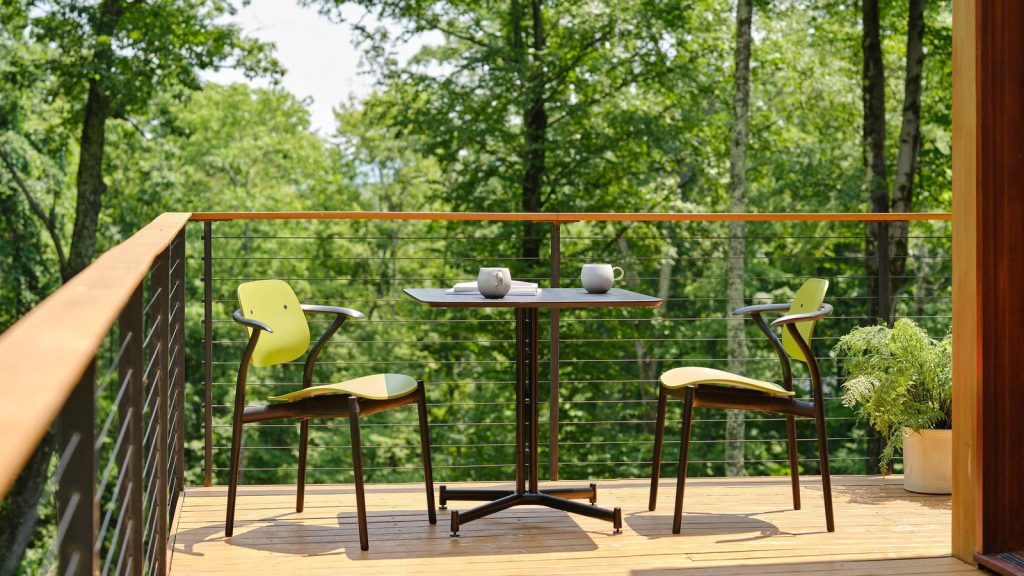Knoll Iquo collection by Ini Archibong
Photo courtesy of Knoll
Ini Archibong is internationally celebrated for his poetic, sculptural approach to design, which often draws on mythology, spiritual symbolism and an intuitive sense of form. Whether working with glass, stone or wood, his creations straddle the worlds of art and function, inviting reflection, emotion and sensory engagement. His work has appeared in museums, biennales and luxury interiors yet always maintains a personal, almost meditative sensibility that balances his creative language with the DNA of the companies he collaborates with.
In this conversation, Archibong discusses the philosophical underpinnings of his work and how he approaches material, collaboration and legacy. From limited-edition pieces to mass-produced objects for leading global brands, he shares how beauty, intuition and intention guide his creative decisions – and how even the shape of a piece of furniture or a shadow cast through glass can offer a moment of the sublime.
For collectors of your work, do you want them to have a transcendent experience when they see or touch it?
I don’t necessarily have any expectations. But if I’ve done something well, I hope that transcendental experience happens naturally – just giving someone a single moment to stop and contemplate beauty. That, to me, is already touching the sublime. If I create a piece that someone places in their home, and every time they walk into the room they pause for a second to appreciate how light filters through colored glass or the curve of a coffee table, I feel like that’s tapping into something spiritual in itself.
Do you have favorite materials or colors to work with?
I wouldn’t say I have favorites, but at any given time I tend to be focused on one material. For example, glass – there’s still so much to explore with it. I’ve also had obsessive phases with stone and wood. It just depends on what I’m trying to express at a particular moment.
Helios tables for Sé Collection IV
Photo courtesy of Sé Collections
When working with legacy brands, how much creative freedom do you have versus meeting their expectations?
Brands like Hermès, Knoll or Sé choose to work with me because there’s something about what I do that they want for their catalog. These brands are smart enough not to be restrictive. I also draw on my experience with Eight Inc. – one of the most important branding companies of our generation that created the Apple stores – to find meaningful ways to connect with a brand’s identity. So when I design for these companies, I try to make something that’s both emblematic of their brand and my own creative voice.
How do you decide which brands to work with and which to avoid?
It’s pretty intuitive. I think that it’s a self-filtering system. I don’t pitch to brands; the collaborations happen organically. A conversation happens and something builds from there. But I’m very selective because I hold my legacy dear. I choose to work with brands that create pieces meant to last – things that can outlive me. From the outset, I’ve had in mind a list of brands I wanted to work with, and I’ve been fortunate to have had opportunities to work with those brands. I’m especially drawn to industry leaders in any particular field – the kind of companies that make the world’s best of something, whether that’s handcrafted bicycles or fine furniture. That’s the kind of challenge I love.
What do you enjoy about working on limited-edition versus mass-produced objects?
I enjoy both for different reasons. Both are fun and both have their limitations. Limited editions or unique pieces give me total creative freedom – it’s like being a child with Legos or being handed a block of wet clay. You don’t have to think about restrictions, the practical things that go into making a mass-produced piece or making a branded object, and that can be freeing. It becomes pure expression, which has its place. But then it’s an amazing and rewarding challenge to work with a company like Knoll to create probably some of the most restrictive kinds of technical pieces that I’ve done, like the injection-molded chair. There are so many different parameters for something that’s mass-produced that’s meant for a worldwide market – it needs to be ergonomic, durable, stackable and weatherproof. It also makes the work accessible to more people, which is a big plus.

